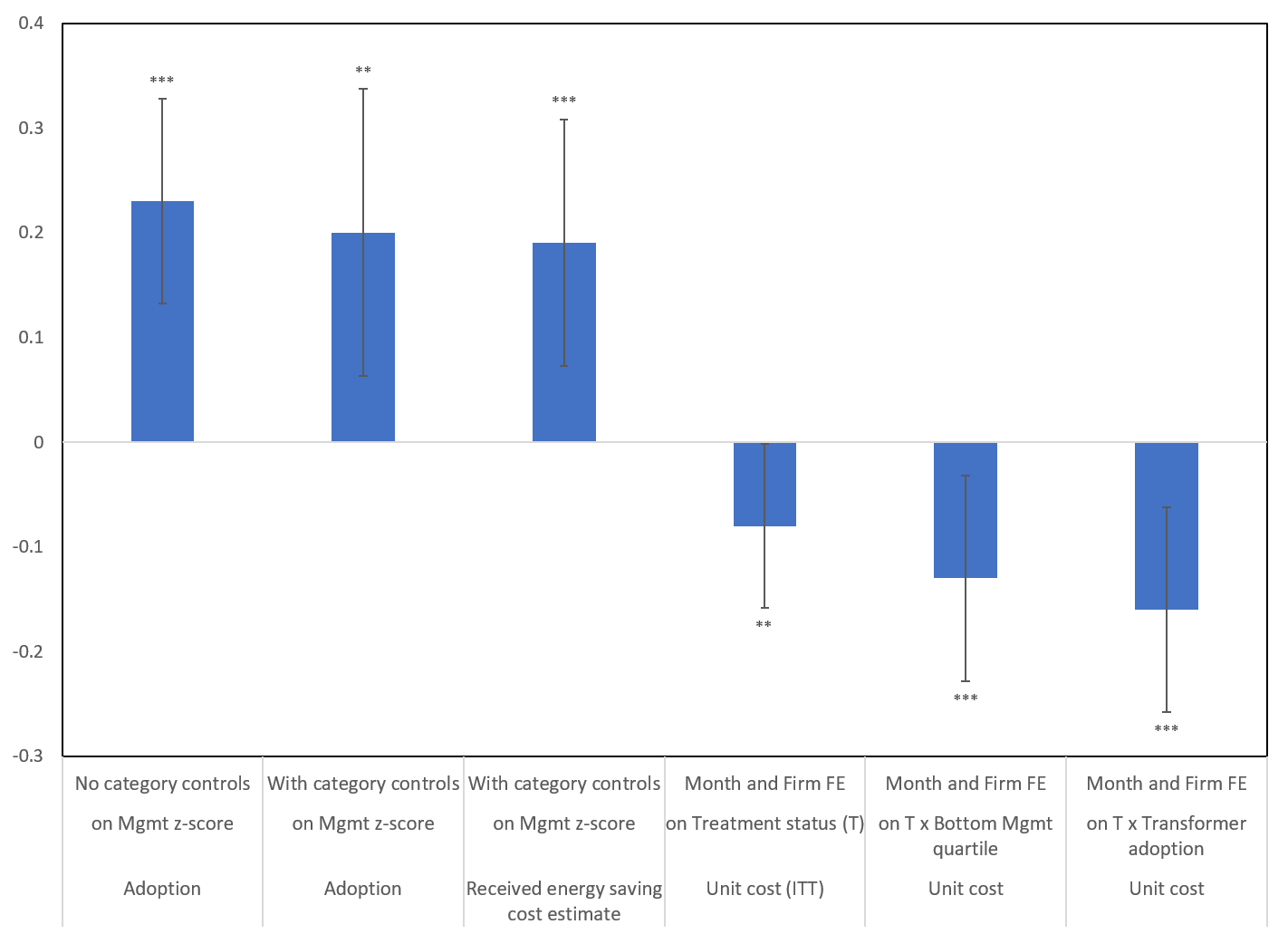CEEPR Working Paper
2022-009, June 2022
Valerie J. Karplus and Da Zhang
Industrial energy efficiency plays a central role in projections that achieve net zero greenhouse gas (GHG) emissions by mid-century. According to the IPCC, industry accounts for 33% of total emissions of the major global carbon dioxide (CO2) due to its reliance on fossil fuels, especially coal, for electricity and process and building heating (Fischedick et al. 2014). China’s industry accounts for 55% of the nation’s primary energy use (NBS, 2018), or 12% of the global total (IEA, 2019).
Our experiment studies the relationship between management practices and electricity use outcomes in metal machining firms. While much of China’s industrial energy use is concentrated in energy-intensive manufacturing (e.g., iron and steel, cement), high value-added manufacturing—which includes the metal machining firms in our study—accounts for fully 7% of the nation’s energy use (NBS, 2018). Prior studies have found that firms will more developed structured practices are less energy intensive and less polluting (Bloom et al., 2010; Boyd and Curtis, 2014; Martin et al., 2012). However, until now these interactions have never been studied in the context of a randomized intervention. Mechanisms are also poorly understood. Could management practices play a role in helping firms to deeply reduce CO2 emissions?
We design a randomized experiment that provides small- and medium-sized metal machining firms with tailored recommendations to improve energy efficiency. The assessment of opportunities for each firm begins with the same menu of recommendations. We hypothesize two competing effects. On the one hand, the preexisting relationship between management practices and energy efficiency may limit the uptake and impact of our energy efficiency intervention, if management practices previously led firms to reap “low-hanging fruit,” i.e., low cost energy saving opportunities. We call this the baseline effect. On the other hand, management disciplines may increase the intervention’s impact, if it motivates or coordinates employees’ efforts to realize energy savings from the intervention. We call this the cognition effect.
We test the net impact of these hypothesized competing effects and examine underlying mechanisms in a sample of 48 single-plant metal machining firms located in Jinan City, Shandong Province, China over six years. We measure generic management practices using the World Management Survey questionnaire (Bloom and Van Reenen, 2007) and energy-centric management practices using a survey we developed. We report two main findings.

Figure 1. Relationship between management practice scores and the uptake and impact of an energy efficiency intervention.
Estimates show effect sizes in log points, and error bars indicate 95% confidence intervals. FE – Fixed Effects. ITT – Intent to Treat.
Statistical significance is indicated by the asterisks *** p < 0.01; ** p < 0.05; * p < 0.1.
First, we find that the likelihood of recommendation adoption is positively and significantly associated with measures of structured management practices, consistent with a dominant role for the cognition effect. As shown in the Figure above, a one standard deviation increase in management score increases the probability of adoption by 20-23 percentage points, statistically significant at the 5% level. We find a significantly higher probability of adopting recommendations that required the least customization. Among management disciplines, monitoring, targets, and incentives (human resource practices such as performance-based pay and promotion) are all positively correlated with adoption.
Second, we show that the intervention’s main effect, a reduction in the unit cost of electricity, is larger in firms with less developed structured practices. Limiting the interaction to just the bottom quartile of low-scoring firms (see Figure), we find that this group is largely responsible for the unit cost effect, driving the overall unit cost reduction (significant at the 1% level): on average, firms in the bottom management quartile realized a unit cost reduction of 13% on average. We find that this effect can be traced to managers’ suboptimal selection of transformer-related parameters at baseline, which resulted in higher electricity costs. The transformer-related recommendation alerted firms that they could reduce their energy costs by resizing their transformer or, in many cases, accurately reporting their maximum load to the grid company. Many firms’ settings were found to deviate from the recommended optimum to various degrees. These deviations proved to be largest among the least well-managed firms, resulting in their paying higher electricity unit cost at baseline. As shown in the Figure, the effect size is larger when we condition on receiving the transformer adjustment recommendation. This effect is most strongly associated with low monitoring, target-setting, and incentive practice scores, providing evidence consistent with an “energy management gap” (and thus spillovers from management to energy management) discussed in Boyd and Curtis (2014) and Martin et al. (2012). Our energy efficiency intervention had no net effect on the quantity of electricity use. Since the GHG intensity of the local electricity supply did not change during this period, our intervention also had no net effect on GHG emissions.
Based on our findings, we reach several conclusions. Our adoption results suggest that structured management practices may help firms absorb new ideas that are expected to reduce physical energy use and greenhouse gas emissions. At the same time, tailoring interventions to address management practice gaps in low-scoring firms may unlock opportunities to save energy cost, by closing the “energy management gap,” but the result could be an increase rather than a decrease in energy use and GHG emissions if the recommendation mechanically reduces energy cost. Since many energy efficiency interventions incentivize firm participation by focusing on potential cost savings, these behavioral effects could offset the environmental benefits of these programs, especially in developing country firms where these behavioral effects could be stronger (Fowlie and Meeks, 2021).
Interestingly, firms’ pre-treatment adoption of the recommendations offered by our intervention did not vary with management practice scores, but unit-cost of electricity did. One potential reason is that managers of well-managed firms may have felt very limited to no external pressure to limit energy use for its own sake or for environmental reasons but were simply—and unknowingly—reaping spillovers from good management practices. Since firms in our setting were too small to be targeted by energy-saving policies during this period, firm responses and their interaction with management practices may well be very different in countries where firms face substantial policy or shareholder pressure. Understanding the interactions between external climate mitigation pressures and internal firm management disciplines in driving energy decisions represents an important frontier for future research.
References
Bloom N, Genakos C, Martin R, Sadun R (2010) “Modern Management: Good for the Environment or Just Hot Air?” Econ. J. 120(544):551–572.
Bloom N, Van Reenen J (2007) “Measuring and explaining management practices across firms and countries.” Q. J. Econ. 72(4):1352–1408.
Boyd GA, Curtis ME (2014) “Evidence of an “Energy-Management Gap” in US manufacturing: Spillovers from firm management practices to energy efficiency.” J. Environ. Econ. Manage. 68(3):467–479.
Fischedick M, Roy J, Abdel-Aziz A, Acquaye A, Allwood JM, Ceron JP, Geng Y, Kheshgi H, Lanza A, Perczyk D, Price L, Santalla E, Sheinbaum C,
Tanaka K (2014) “Contribution of Working Group III to the Fifth Assessment Report of the Intergovernmental Panel on Climate Change.” Climate Change 2014: Mitigation of Climate Change, 739-810 (Cambridge University Press).
Fowlie M, Meeks R (2021) “The Economics of Energy Efficiency in Developing Countries.” Rev. Environ. Econ. Pol. 15(2):238–260.
International Energy Agency (2019) World Energy Outlook (International Energy Agency).
Karplus V.J, Zhang D (2022) “When ‘Low-Hanging Fruit’ Are Beyond Reach: Management Practices and Firm Energy Efficiency,” MIT CEEPR Working Paper 2022-009, June 2022.
Martin R, Muuls M, de Preuxe LB, Wagner UJ (2012) “Anatomy of a paradox: Management practices, organizational structure and energy efficiency.” J. Environ. Econ. Manage. 63(2):208–223.
National Bureau of Statistics of China (2018) China Energy Yearbook (National Bureau of Statistics of China).




